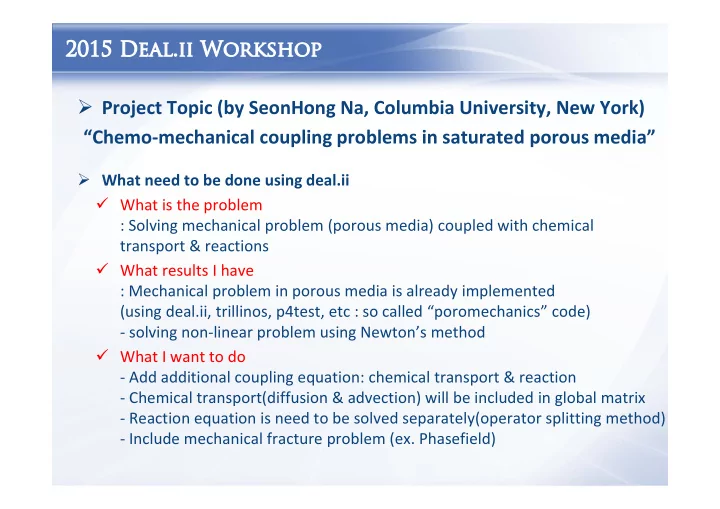

Project Topic (by SeonHong Na, Columbia University, New York) “Chemo ‐ mechanical coupling problems in saturated porous media” What need to be done using deal.ii What is the problem : Solving mechanical problem (porous media) coupled with chemical transport & reactions What results I have : Mechanical problem in porous media is already implemented (using deal.ii, trillinos, p4test, etc : so called “poromechanics” code) ‐ solving non ‐ linear problem using Newton’s method What I want to do ‐ Add additional coupling equation: chemical transport & reaction ‐ Chemical transport(diffusion & advection) will be included in global matrix ‐ Reaction equation is need to be solved separately(operator splitting method) ‐ Include mechanical fracture problem (ex. Phasefield)
Project Topic (by SeonHong Na, Columbia University, New York) “Chemo ‐ mechanical coupling problems in saturated porous media” • Governing equation • Using Newton’s method - Momentum balance - Residuals � � (mechanical problem in porous media) � � � ∙ � � � ��� � � � � � � � � � � � �: ��; � � � � � � � � ��� � �� � �� where � � � - Mass balance equation - Tangent matrix (fluid flow in porous media, seepage velocity) � � � � � � �� ∙ � � � � ∙ � � 0 � � � � � � � � � � � � � � � � � � where, � � � ∙ ��� � � � �� � � � � � � � � � � � � � � � � - Chemical transport equation(3) & reaction equation(1) ���Ψ � � - Solutions � � � ∙ � Ψ � � � ∙ �� � �Ψ � � �� �� �� � � �� � �� �� � �� 1 � � �� � � � � �� � �� � H � , Ca �� , CO � � �� � � � �
Approach (Algorithm) • The first step Compute the free ‐ ion and complex concentrations New time step - from the previous iteration’s or time step’s (in the case of the first iteration) total component concentrations step Ⅰ according to prescribed equilibrium equations and New iteration uses these concentrations to calculate reaction rates for the transport equations. <Speciate > Calculate free ‐ ion and • The second stope complex concentrations Involves solving the governing reactive transport - equations (including mechanical equations) based on Compute kinetic reaction rates for prescribed reaction rate laws and the previous aqueous and mineral components iteration’s concentrations step Ⅱ • During the first step Utilize the Newton ‐ Raphson method to carry out - Solve transport “speciation”, where individual free ‐ ion and complex equations(governing equation) for concentrations are computed. Then, estimates kinetic total aqueous concentrations source/sink reaction rates as a function of these aqueous concentrations Calculate new mineral concentration explicitly • In the second step Implements the finite element method along with a - Yes No specialized matrix solver to compute a solution to the Check convergence reactive transport equations
Recommend
More recommend